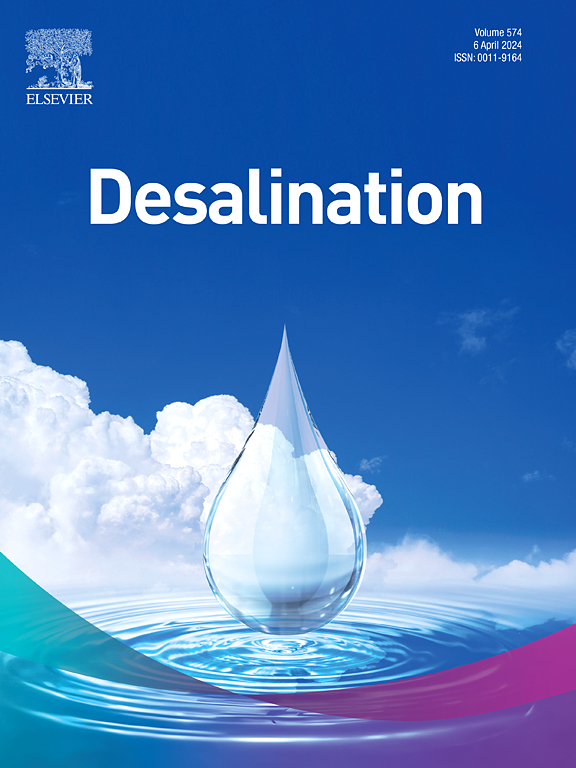Photothermal-photocatalytic bifunctional highly porous hydrogel for efficient coherent sewage purification-clean water generation
IF 9.8
1区 工程技术
Q1 ENGINEERING, CHEMICAL
引用次数: 0
Abstract
Solar interfacial water evaporation based on photothermal materials presents great potential in tackling global water scarcity and environmental pollution. However, existing photothermal materials still suffer from performance deficiencies like insufficient evaporation rate and unreliable long-term stability, as well as single-function limitations leading to incomplete removal of contaminants from wastewater, severely hindering their practical applications. Herein, we develop a novel, cost-effective, highly porous hydrogel composite integrated with synchronous photothermal and photocatalytic effects by a facile two-step immobilization approach. This method involves an initial sonication-induced pre-polymerization of acrylamide to produce a viscous solution that uniformly disperses TiO2 nanoparticles and single-walled carbon nanotubes (SWCNTs), followed by a secondary in-situ free radical polymerization to achieve stable homogeneous TiO2/SWCNTs/polyacrylamide (PAM) hydrogel composite with an ultrahigh porosity of 88.40 %. Remarkably, the resultant hydrogel composite simultaneously exhibits excellent bifunctional photothermal and photocatalytic performances, including exceptional sunlight absorption of 99.35 %, high evaporation rate of 3.53 kg m−2 h−1, and high photodegradation efficiency of 84.27 % for methylene blue. Furthermore, the water evaporator fabricated with such hydrogel demonstrates consistent desalination performance over 40-day continuous monitoring with salt ion removal rates over 95 %, positioning it as a promising bifunctional material for coherent sewage purification and clean water generation.

光热-光催化双功能高多孔水凝胶,用于高效的污水净化-净水生产
基于光热材料的太阳界面水蒸发在解决全球水资源短缺和环境污染方面具有巨大的潜力。然而,现有光热材料仍然存在蒸发速率不足、长期稳定性不可靠等性能缺陷,以及单一功能限制导致废水中污染物的去除不完全,严重阻碍了光热材料的实际应用。在此,我们开发了一种新型的,具有成本效益的,高多孔的水凝胶复合材料,通过简单的两步固定化方法集成了同步光热和光催化效应。该方法首先对丙烯酰胺进行超声诱导预聚合,生成一种黏性溶液,使TiO2纳米颗粒和单壁碳纳米管(SWCNTs)均匀分散,然后进行二次原位自由基聚合,获得具有88.40%超高孔隙率的稳定均匀的TiO2/SWCNTs/聚丙烯酰胺(PAM)水凝胶复合材料。值得注意的是,合成的水凝胶复合材料同时具有优异的双功能光热和光催化性能,包括99.35%的太阳光吸收率,3.53 kg m−2 h−1的高蒸发率,以及84.27%的亚甲基蓝光降解效率。此外,用这种水凝胶制成的蒸发器在40天的连续监测中表现出一致的脱盐性能,盐离子去除率超过95%,使其成为一种有前途的污水净化和净水生产双功能材料。
本文章由计算机程序翻译,如有差异,请以英文原文为准。
求助全文
约1分钟内获得全文
求助全文
来源期刊

Desalination
工程技术-工程:化工
CiteScore
14.60
自引率
20.20%
发文量
619
审稿时长
41 days
期刊介绍:
Desalination is a scholarly journal that focuses on the field of desalination materials, processes, and associated technologies. It encompasses a wide range of disciplines and aims to publish exceptional papers in this area.
The journal invites submissions that explicitly revolve around water desalting and its applications to various sources such as seawater, groundwater, and wastewater. It particularly encourages research on diverse desalination methods including thermal, membrane, sorption, and hybrid processes.
By providing a platform for innovative studies, Desalination aims to advance the understanding and development of desalination technologies, promoting sustainable solutions for water scarcity challenges.
 求助内容:
求助内容: 应助结果提醒方式:
应助结果提醒方式:


